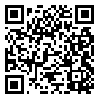Volume 15, Issue 5 (Dec 2021 & Jan 2022)
payavard 2022, 15(5): 446-459 |
Back to browse issues page
Download citation:
BibTeX | RIS | EndNote | Medlars | ProCite | Reference Manager | RefWorks
Send citation to:



BibTeX | RIS | EndNote | Medlars | ProCite | Reference Manager | RefWorks
Send citation to:
Soleymanpor M, Amini M T, Shirmohammadi Y, Shahnazari A. Modeling and Analyzing the Dimensions of Tourism with an Entrepreneurial Approach in Pandemic Crises (Covid 19): Mixed Method. payavard 2022; 15 (5) :446-459
URL: http://payavard.tums.ac.ir/article-1-7128-en.html
URL: http://payavard.tums.ac.ir/article-1-7128-en.html
1- Ph.D. Candidate in Business Management, Payam-e-Noor University, Tehran, Iran , m.soleymanpor@pnu.ac.ir
2- Professor, Department of Business Management, Payam-e-Noor University, Tehran, Iran
3- Associate Professor, Department of Business Management, Payam-e-Noor University, Tehran, Iran
4- Assistant Professor, Department of Business Management, Payam-e-Noor University, Tehran, Iran
2- Professor, Department of Business Management, Payam-e-Noor University, Tehran, Iran
3- Associate Professor, Department of Business Management, Payam-e-Noor University, Tehran, Iran
4- Assistant Professor, Department of Business Management, Payam-e-Noor University, Tehran, Iran
Abstract: (1515 Views)
Background and Aim: With the global expansion of Covid 19, the tourism industry has faced one of its biggest operational, commercial and financial crises, and most of the source-destination interactions have been suspended and have changed the view of the host community and their interactions with tourists. The purpose of this study is to provide a model for tourism development during the Covid 19 crisis and beyond.
Materials and Methods: This study was conducted using a combined (qualitative-quantitative) research approach. First, in a qualitative method with the data foundation approach, interviews with academic experts and managers and activists of the tourism industry in East and West Azerbaijan Provinces, and using purposeful and theoretical sampling, 18 people were selected to the point of information saturation. Semi-structured in-depth interviews were used to collect data. Data extracted from interviews were encoded by open, axial and selective coding. Then, to fit and test the obtained model in the second step (quantitative part), the method of structural equation modeling and confirmatory factor analysis were used.
Results: The final model consists of a total of 66 concepts extracted from the interviews, in the form of 14 categories and contextual categories, causal conditions, interventional conditions, strategies and finally, consequences and results of tourism entrepreneurship in pandemic crises and all of them affect this model. Based on the results of combined reliability, extracted variance, model determination coefficient and goodness-of-fit index, the drawn model in the field of path analysis has good experimental-theoretical assumptions and has a very good fit. Based on the obtained path coefficients, it can be concluded that the intervention conditions had the most and the causal conditions had the least impact on the strategic model of the tourism industry in pandemic crises.
Conclusion: Results indicate that strategies such as virtual tourism development, crisis management in the tourism industry, the development of domestic tourism by emphasizing the observance of health protocols and focusing on the development of tourism infrastructure, leads to the realization of consequences such as the maintenance and prosperity of tourism businesses, strengthening the tourism industry and creating a new tourism market for the post-corona era.
Materials and Methods: This study was conducted using a combined (qualitative-quantitative) research approach. First, in a qualitative method with the data foundation approach, interviews with academic experts and managers and activists of the tourism industry in East and West Azerbaijan Provinces, and using purposeful and theoretical sampling, 18 people were selected to the point of information saturation. Semi-structured in-depth interviews were used to collect data. Data extracted from interviews were encoded by open, axial and selective coding. Then, to fit and test the obtained model in the second step (quantitative part), the method of structural equation modeling and confirmatory factor analysis were used.
Results: The final model consists of a total of 66 concepts extracted from the interviews, in the form of 14 categories and contextual categories, causal conditions, interventional conditions, strategies and finally, consequences and results of tourism entrepreneurship in pandemic crises and all of them affect this model. Based on the results of combined reliability, extracted variance, model determination coefficient and goodness-of-fit index, the drawn model in the field of path analysis has good experimental-theoretical assumptions and has a very good fit. Based on the obtained path coefficients, it can be concluded that the intervention conditions had the most and the causal conditions had the least impact on the strategic model of the tourism industry in pandemic crises.
Conclusion: Results indicate that strategies such as virtual tourism development, crisis management in the tourism industry, the development of domestic tourism by emphasizing the observance of health protocols and focusing on the development of tourism infrastructure, leads to the realization of consequences such as the maintenance and prosperity of tourism businesses, strengthening the tourism industry and creating a new tourism market for the post-corona era.
Send email to the article author
| Rights and permissions | |
 |
This work is licensed under a Creative Commons Attribution-NonCommercial 4.0 International License. |





